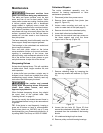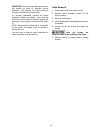
25
Troubleshooting – Mechanical and Electrical Problems
Trouble Probable Cause Remedy
No incoming power.
Verify unit is connected to power, on-
button is pushed in completely, and
stop-button is disengaged.
Overload automatic reset has not
reset.
When jointer overloads on the circuit
breaker built into the motor starter, it
takes time for the machine to cool
down before restart. Allow unit to
adequately cool before attempting
restart. If problem persists, check
amp setting on the motor starter
inside the electrical enclosure – it
should match the amps on the motor
as indicated on the motor plate.
Jointer frequently trips.
One cause of overloading trips which
are not electrical in nature is too
heavy a cut. The solution is to take a
lighter cut. If too deep a cut is not the
problem, then check the amp setting
on the overload relay. Match the full
load amps on the motor as noted on
the motor plate. If amp setting is
correct then there is probably a loose
electrical lead.
Building circuit breaker trips or fuse
blows.
Verify that jointer is on a circuit of
correct size. If circuit size is correct,
there is probably a loose electrical
lead. Check amp setting on motor
starter.
Switch or motor failure (how to
distinguish).
Examine motor starter for burned or
failed components. If damage is
found, replace starter. If no visible
damage found, have starter tested.
If you have access to a voltmeter, you
can separate a starter failure from a
motor failure by first, verifying
incoming voltage at 220+/-20 and
second, checking the voltage
between starter and motor at 220+/-
20. If incoming voltage is incorrect,
you have a power supply problem. If
voltage between starter and motor is
incorrect, you have a starter problem.
If voltage between starter and motor
is correct, you have a motor problem.
Machine will not
start/restart or
repeatedly trips
circuit breaker or
blows fuses.
Motor overheated.
Clean motor of dust or debris to allow
proper air circulation. Allow motor to
cool down before restarting.


















